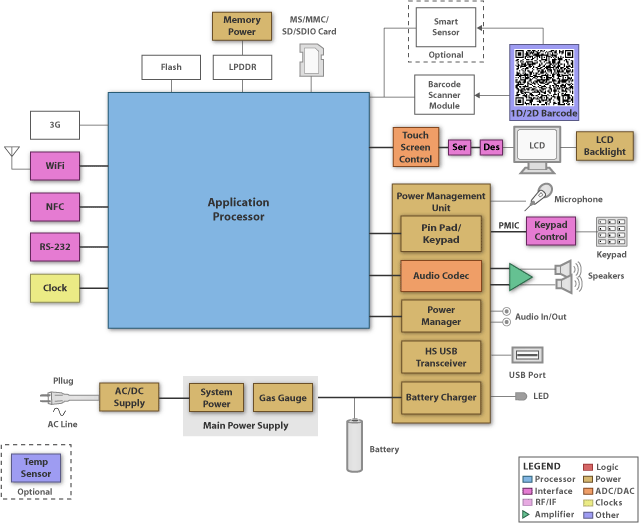
Design Considerations
Portable Data Terminal (PDT) also known as handheld data terminal or handheld computer, is a rugged portable computing device used in many shipping, logistics and inventory management applications to enable greater efficiency of the mobile work force in many industries. The main features of the product are mobile computing with integrated camera, bar code scanner and wireless connectivity to communicate and access information on remote servers.
The product requires an operating system that allows for custom applications, remote updates and ease-of-use in the field. These products are encased in rugged enclosures to enable all weather usage as well as the ability to withstand drops and falls in a factory floor or warehouse environment.
The core system includes:
• Processor – The Sitara ARM processor is based on the (up to) 1GHz ARM Cortex-A8 CPU and POWERVR SGX™ Graphics Accelerator. This best-in-class ARM and graphics architecture is integrated into the 45nm process technology and is optimized for performance while delivering low-power consumption. The balance of performance and power make this device ideal for Portable Data Terminal applications.
• Barcode Scanning and Camera Ports – 1D and 2D barcode scanning abilities can be supported with multiple serial IOs on the Sitara AM3715 application process to support the laser readers. Additionally, camera ports used in 2D and 3D scanners. The ARM Cortex-A8 core fully supports the processing requirements of the scanning algorithm to capture and parse the Universal Product Code (UPC). The high performance of the AM3715 ARM core can support: 1D/2D laser readers, 2D/3D CMOS camera sensors, and Universal Product Code (UPC) scanning algorithm.
• Network Interface – The key advantage of a PDT is full duplex wireless communication with remote servers and data storage facilities. Most systems require IEEE 802.11abgn wireless LAN as well 2G/3G/4G cellular modems to allow for true mobility. The high-performance WL1271 Transceiver chip offers 2.4GHz IEEE 802.11 b/g/n and Bluetooth v2.1 + Enhanced Data Rate (EDR) transceivers. The WL1271 also provides best-in-class coexistence capabilities coupled with TI’s Enhanced Low Power (ELP) technology – helping customers reduce development time, lower manufacturing costs, and ease certification.
• GPS – The TI WLAN chipset supports the location aware and tracking application requirements of a GPS solution.
• Touch Screen Interface – Requirement for touch screen control allows for PDT ease-of-use in the field. This feature is enabled on-chip on some of the Sitara processors or available via external touch screen controllers from the TSC series of products.
• Power Management – TI has a wide range of power management IC's from discrete LDOs to highly-integrated PMICs (Power Management Integrated Circuits). These PMIC’s provide the PDT with a solution to generate and regulate core, memory and IO power. They also provide an efficient, eco-friendly power solution for touch screen controllers, key pad interfaces, and USB transceivers.
Click here for Guide
Download Full Block Diagram Below
Advertisement

Learn more about Texas Instruments





